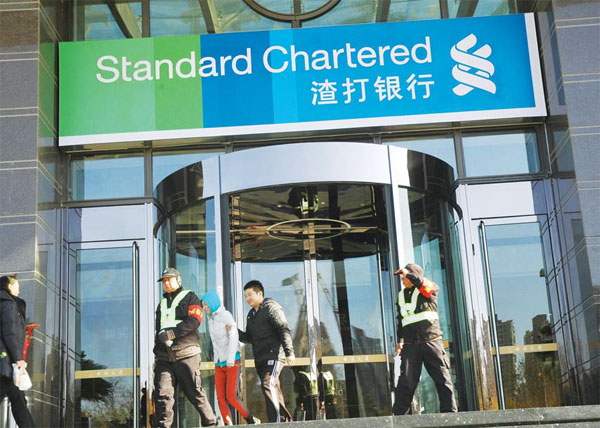Banks take baby steps into China

| The branch of Standard Chartered was opened in Zhengzhou, Henan province in November. International banks like HSBC, Citibank and Deutsche Bank are expanding their presence in China. Provided to China Daily |
Focus is on corporate business as domestic players' dominance means retail sector is tough nut to crack
Foreign banks continue to make inroads in China, but after years of expanding their networks they remain marginal players in retail and consumer spaces.
Still, they are chipping away slowly, building market share and expanding their presence in the financial services sector and among their corporate clients. And regulators are encouraging them.
A series of regulatory announcements last year opened the door for more international activity like trade and cross-border financing at which global banks excel.
Through the last half of 2013, regulators in the Chinese mainland announced a series of reforms that pave the way for the further internationalization of the yuan, the liberalization of interest rates and even the creation of the Shanghai Free Trade Zone where foreign banks can offer more services.
In the past few weeks, the People's Bank of China suggested it may further ease restrictions on bond trading. On April 10, the PBOC opened the door to cross-border investment between stock exchanges in Hong Kong and the Chinese mainland. While financial institutions broadly welcomed these moves, the impact might be limited.
In a report in January, foreign banks are generally optimistic about the prospects for the China market, but worry about complex regulations that combine with capital and liquidity constraints to make their growth difficult.
By the end of 2012, according to the China Banking Regulatory Commission, there were 42 locally incorporated foreign banks in China and another 370 branches or subsidiaries.
All told, they had assets of 2.3 trillion yuan ($1.8 trillion) but their market share is paltry and remains concentrated in the big cities where they can reach corporate customers.
Although they are expanding geographically in China, foreign banks tend to be concentrated around Guangzhou, Shenzhen, Shanghai, Beijing and Tianjin.
There is a smattering of branches elsewhere but they exist to service a handful of corporate clients. Besides the Chinese domestic giants, the largest networks belong to Bank of East Asia, DBS of Singapore, Hang Seng Bank of Hong Kong, Citibank, HSBC and Standard Chartered.
Margins are generally getting tighter for all of them. Among the executives in 38 banks that EY interviewed for its January report, as many as 33 expect their margins from interest rates to get smaller.
On the other hand, a significant majority of 25 respondents expect to see slight improvements in the market while seven are much more optimistic. The regulatory opening is likely to help to some degree but is not likely to lead to any great surge in market share.
"The benefits for the foreign bankers also significantly depend on the scope, interpretation, timing and implementation of the proposed changes," says Geoffrey Choi, assurance leader for financial services in China at EY.
International banks like HSBC, Standard Chartered, Citibank, UBS and Deutsche Bank, along with a host of other regional players like Overseas-Chinese Banking Corporation (OCBC) and DBS in Singapore or Maybank in Malaysia, are expanding their presence.
They are gaining mandates in areas like trade financing, corporate mergers or acquisitions and even larger deals like initial public offerings but, so far, they have not really managed to tap into the retail market. To date, they account for just 2 percent of the market - 1.82 percent at the end of 2012.
For the foreseeable future, the prospects for the banking industry in China appear to be good.
In a report earlier this month, rating agency Standard & Poor's said that a "prolonged crisis is unlikely" and that ongoing economic growth, which is likely to stay above 7 percent until at least 2016 will "limit the systemic risk for Chinese banks".
This should also be good news for foreign banks that are looking to China for ongoing growth.
HSBC, which has 160 outlets in 52 cities in China and 30 branches in Beijing alone, expects much from the China market. Much of the bank's growth there is likely to come from financing deals like issuing yuan-denominated bonds.
In a presentation to investors in March, bank executives noted that the yuan is now the second most-used currency in trade finance and that by next year, about 30 percent of China's trade, or $2 trillion, will be settled in yuan.
Citibank, which became a locally incorporated bank in 2007, has 55 branches and subbranches in 13 cities with 8,000 staff. In 2012, it became the first global bank to issue a sole-branded credit card, tapping into the expanding consumer market.
Regional banks are also looking to expand their exposure to China. Singapore banks like OCBC and DBS have both undertaken deals to expand their footprint.
DBS was the second bank to be given the green light to set up a sub-branch in the new Shanghai Free Trade Zone to add to the nine outlets the bank has in the city.
By January 2014, Citibank, HSBC, Hang Seng, Deutsche Bank, United Overseas Bank and ANZ had all received the go-ahead as well.
Standard Chartered has been expanding its branch network in China for several years and now has 104 branches, 164 ATMs and 8,500 employees. The bank is positive about the future there.
"In our view, China poses less risk than many Western analysts believe," said the bank in its annual report for 2013. "China will encounter adjustment strains as it reshapes its economy and financial markets, but these are unlikely to knock the country off a growth rate of around 7 percent."
China Daily
(China Daily European Weekly 05/02/2014 page15)
Today's Top News
- Takaichi must stop rubbing salt in wounds, retract Taiwan remarks
- Millions vie for civil service jobs
- Chinese landmark trade corridor handles over 5m TEUs
- China holds first national civil service exam since raising eligibility age cap
- Xi's article on CPC self-reform to be published
- Xi stresses improving long-term mechanisms for cyberspace governance































